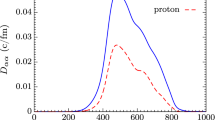Abstract
An scission point model improved by including angular momentum effects is used to study the recently reported heavy-ion-induced fission of \(^{181} \hbox {Re}^*\) formed in the \(^{12}\)C+\(^{169}\)Tm reaction at three different lab energies, especially to estimate the fragment cross section. The fission is characterized as a two-stage process. Through energy balance criteria the scission point for each fragmentation is identified in the first stage. The respective formation probability is calculated using deformed Nilsson single-particle levels. The WKB approximation is used to determine the probability of fragments to penetrate the potential barrier in the second stage. Using partial wave analysis, the cross section is calculated. The yield values exhibit a clear demarcation of the asymmetric and symmetric regions. The cross section values are found to have a strong dependence on the scission distance. With the proper choice of scission distance, the model could account for the observed cross section properties of \(^{181} \hbox {Re}^*\). The calculated cross section values are found to agree with experimental data, at least in the symmetric division. In addition to mass distribution and cross section calculations, the model can be exploited to study other fission observables too.











Similar content being viewed by others
Data Availability Statement
This manuscript has no associated data or the data will not be deposited. [Authors’ comment: The binary fission studies of excited \(^{181} {\hbox {Re}}\) nucleus using the angular momentum dependent scission point model are reported as figures. All data generated during this study are contained in this article.].
Notes
The general notation for Lagrangian multiplier \(\gamma \) in [29] is changed to \(\varUpsilon \) to differentiate from the nuclear surface tension coefficient used in the proximity potential calculation.
\(\beta \) used in [29] to denote a reciprocal of the temperature is replaced with \(\beta _T\) to differentiate with deformation parameter.
References
H.L. Hall, D.C. Hoffman, J. Radioanal. Nucl. Chem. 142, 53 (1990)
B.B. Back, O. Hansen, H.C. Britt, J.D. Garrett, Phys. Rev. C 9, 1924 (1974)
Y. Oganessian, J. Phys. G Nucl. Particle Phys. 34, R165 (2007)
B. Wilkins, E. Steinberg, Phys. Lett. B 42, 141 (1972)
B.D. Wilkins, E.P. Steinberg, R.R. Chasman, Phys. Rev. C 14, 1832 (1976)
J.F. Lemaître, S. Panebianco, J.L. Sida, S. Hilaire, S. Heinrich, Phys. Rev. C 92, 034617 (2015)
C. Karthika, M. Balasubramaniam, Eur. Phys. J. A 55, 59 (2019)
A.V. Karpov, P.N. Nadtochy, E.G. Ryabov, G.D. Adeev, J. Phys. G Nucl. Particle Phys. 29, 2365 (2003)
H. Goutte, J.F. Berger, P. Casoli, D. Gogny, Phys. Rev. C 71, 024316 (2005)
P. Möller, D.G. Madland, A.J. Sierk, A. Iwamoto, Nature 409, 785 (2001)
A.V. Andreev, G.G. Adamian, N.V. Antonenko, Phys. Rev. C 86, 044315 (2012)
A. Sood, P.P. Singh, R.N. Sahoo, P. Kumar, A. Yadav, V.R. Sharma, M. Shuaib, M.K. Sharma, D.P. Singh, U. Gupta et al., Phys. Rev. C 96, 014620 (2017)
C. Kokila, M. Balasubramaniam, Phys. Rev. C 101, 014614 (2020)
A.V. Andreev, G.G. Adamian, N.V. Antonenko, S.P. Ivanova, W. Scheid, Eur. Phys. J. A 22, 51 (2004)
A.V. Andreev, G.G. Adamian, N.V. Antonenko, S.P. Ivanova, W. Scheid, Acta Phys. Hungarica Ser. A Heavy Ion Phys. 22, 3 (2005)
V.Y. Denisov, N.A. Pilipenko, I.Y. Sedykh, Phys. Rev. C 95, 014605 (2017)
G. Scamps, C. Simenel, Nature 564, 382 (2018)
A. Bulgac, S. Jin, K.J. Roche, N. Schunck, I. Stetcu, Phys. Rev. C 100, 34615 (2019)
M. Wang, G. Audi, F. Kondev, W. Huang, S. Naimi, X. Xu, Chin. Phys. C 41, 030003 (2017)
I. Ragnarsson, S. Nilsson, Shapes and Shells in Nuclear Structure (Cambridge University Press, Cambridge, 2005)
W.D. Myers, W.J. Swiatecki, Ark. Fys. 36, 343 (1967)
K. Krane, Introductory Nuclear Physics (Wiley, Hoboken, 1987)
M. Bolsterli, E.O. Fiset, J.R. Nix, J.L. Norton, Phys. Rev. C 5, 1050 (1972)
Y. Gambhir, Mean Field Description of Nuclei (Narosa Pub., 2006), ISBN 9788173197086, https://books.google.co.in/books?id=X8Hrb9e-gMkC (2006)
V.Y. Denisov, N.A. Pilipenko, Phys. Rev. C 76, 014602 (2007)
V.Y. Denisov, Phys. Rev. C 91, 024603 (2015)
J. Blocki, J. Randrup, W. Swiatecki, C. Tsang, Ann. Phys. 105, 427 (1977)
M. Rajasekaran, V. Devanathan, Phys. Rev. C 24, 2606 (1981)
N. Arunachalam, P.A. Periyanayaki, K. Ilangovan, Phys. Rev. C 55, 1826 (1997)
H.A. Bethe, Rev. Mod. Phys. 9, 69 (1937)
K.L. Couteur, D. Lang, Nucl. Phys. 13, 32 (1959)
R.K. Gupta, M. Balasubramaniam, C. Mazzocchi, M. La Commara, W. Scheid, Phys. Rev. C 65, 024601 (2002)
Acknowledgements
One of the authors CK acknowledges the financial support received in the form of JRF by Council of Scientific and Industrial Research, Govt. of India vide sanction No. 03 (1455)/19/EMR-II.
Author information
Authors and Affiliations
Corresponding author
Additional information
Communicated by Cedric Simenel
Rights and permissions
About this article
Cite this article
Karthika, C., Balasubramaniam, M. Scission point model applied to \(^{181} \hbox {Re}^{*}\) formed in \(^{12}{} \mathbf{C}+^{169}\)Tm reaction. Eur. Phys. J. A 56, 148 (2020). https://doi.org/10.1140/epja/s10050-020-00158-0
Received:
Accepted:
Published:
DOI: https://doi.org/10.1140/epja/s10050-020-00158-0



